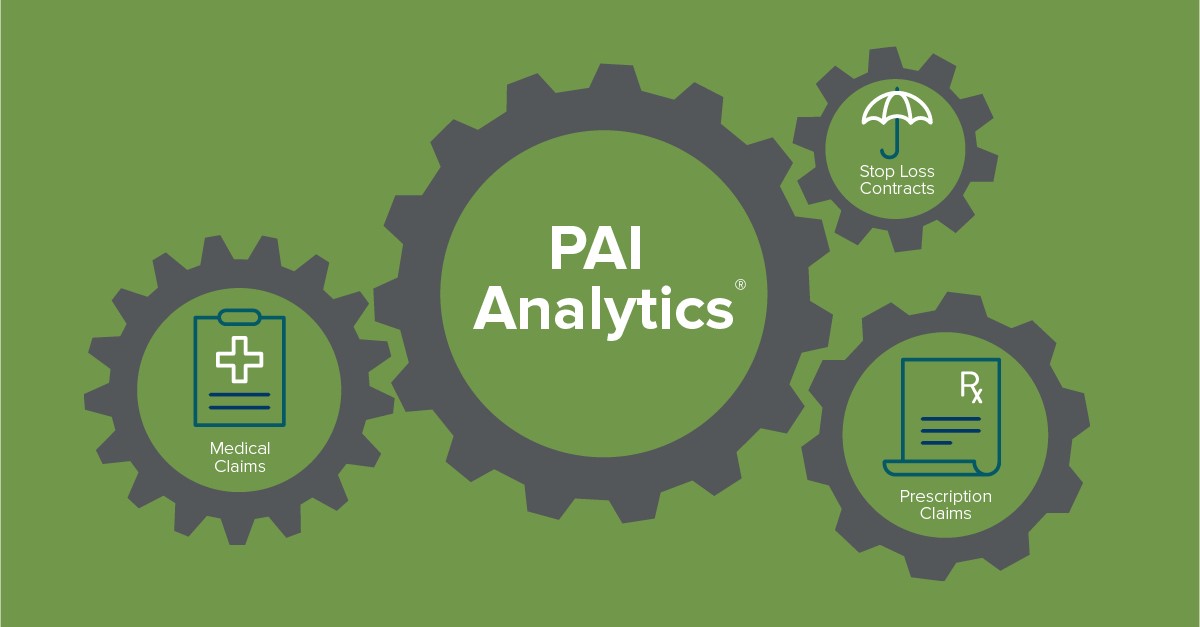Medical Claims + Rx Claims + Stop Loss Contracts = PAI Analytics®
Medical Claims + Rx Claims + Stop Loss Contracts = PAI Analytics®
How PAI Utilizes Key Data Files for Holistic Plan Performance Review
Delivering a thorough plan performance review requires a deep dive into data sources. At PAI, our expertise in managing and analyzing health plan files—including medical, pharmacy, eligibility, and stop-loss contracts is essential for providing a comprehensive plan performance review. Let’s dive in on how each of these file types contributes to a holistic plan performance review and how they help us drive better decision-making and outcomes.

Medical Files
Includes detailed records of patient diagnoses, treatments, procedures, and outcomes submitted by healthcare providers, containing a range of data from regular check-ups to specialized treatments.
- Claims Analysis: Medical files reveal service usage and costs. Analyzing this data helps identify claim trends, treatment frequencies, and spending anomalies.
- Quality of Care: Analyzing medical data allows us to evaluate hospital readmission rates, treatment adherence, and patient outcomes to assess care quality.
- Cost Management: Medical file data evaluates treatment cost-effectiveness, aiding in strategies to reduce overall healthcare costs.
Pharmacy Files
Contain records of prescriptions filled, including medication names, dosages, frequencies, and costs for understanding prescription dynamics of healthcare delivery.
- Medication Utilization: The analysis of pharmacy files helps us understand prescription usage patterns, which can highlight areas for potential intervention or cost control.
- Cost Analysis: These files provide detailed pharmaceutical cost data, helping us identify high-cost drugs and find opportunities for formulary optimization and cost savings.
- Patient Adherence: Analyzing pharmacy data reveals insights into how well patients follow their medication treatment plans, essential for evaluating treatment success and overall wellness.
Eligibility Files
Eligibility files detail members' coverage, including enrollment, dependents, and requirements, confirming coverage and benefits.
- Member Demographics: Knowing the demographic profile of covered members helps us tailor our analysis and strategies to better fit different groups of people.
- Benefit Utilization: Eligibility data helps evaluate how benefits are being used and identify any discrepancies or issues with coverage.
- Compliance and Accuracy: Reviewing eligibility files ensures that all services are processed correctly according to the plan’s terms, reducing the risk of errors and fraud.
Stop-Loss Contracts
Stop-loss contracts provide financial protection for health plans by covering claims that exceed certain thresholds. These contracts are crucial for managing risk and ensuring financial stability.
- Risk Assessment: Stop-loss data helps assess the effectiveness of the plan’s risk management strategies. By analyzing claims that have reached stop-loss thresholds, we can gauge the financial impact of high-cost claims.
- Financial Planning: Understanding stop-loss contract terms helps in forecasting and budgeting for potential high-cost claims, ensuring that the plan remains financially viable.
- Claims Management: Review of stop-loss claims can provide insights into patterns of high-cost claims and assist in developing strategies to mitigate future risks.
Bringing It All Together
A holistic plan performance review isn't just about collecting data—it's about putting it all together to get useful insights. By looking at medical records, pharmacy files, eligibility details, and stop-loss contracts, we can give a full picture that shows trends, spots areas for improvement, and helps with making smart decisions.
Using these files effectively lets us give health plans recommendations, boost patient outcomes, manage costs, and improve the plan's overall performance. In today’s data-driven world, tapping into all these different data sources helps PAI provide a complete view of plan performance and keep driving improvements in healthcare management.
